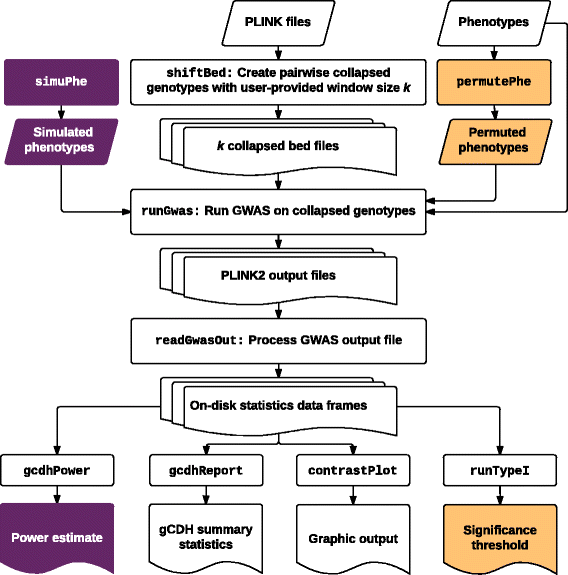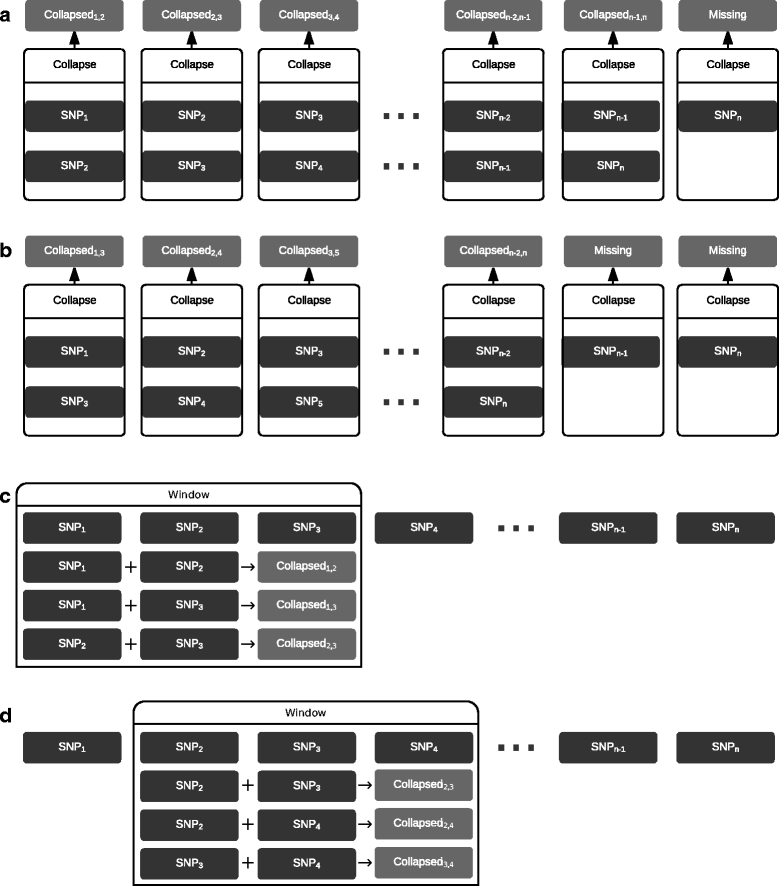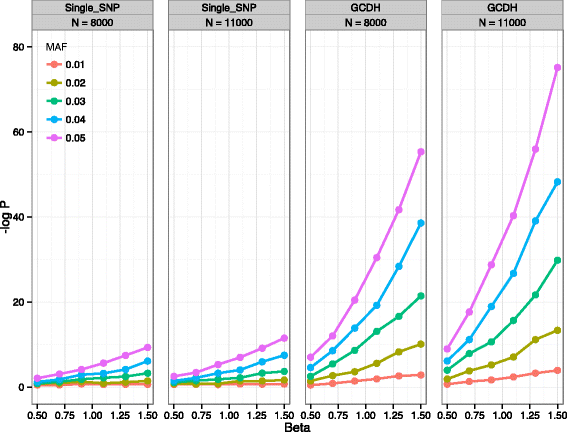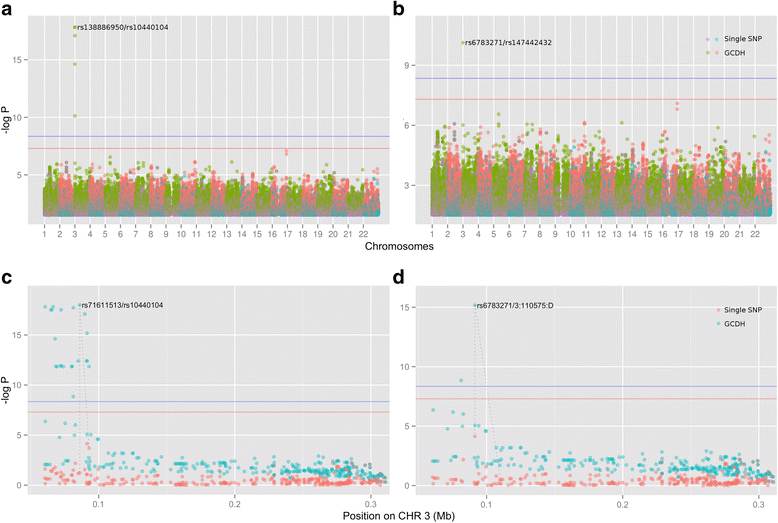CollapsABEL: an R library for detecting compound heterozygote alleles in genome-wide association studies
- PMID: 27059780
- PMCID: PMC4826552
- DOI: 10.1186/s12859-016-1006-9
CollapsABEL: an R library for detecting compound heterozygote alleles in genome-wide association studies
Abstract
Background: Compound Heterozygosity (CH) in classical genetics is the presence of two different recessive mutations at a particular gene locus. A relaxed form of CH alleles may account for an essential proportion of the missing heritability, i.e. heritability of phenotypes so far not accounted for by single genetic variants. Methods to detect CH-like effects in genome-wide association studies (GWAS) may facilitate explaining the missing heritability, but to our knowledge no viable software tools for this purpose are currently available.
Results: In this work we present the Generalized Compound Double Heterozygosity (GCDH) test and its implementation in the R package CollapsABEL. Time-consuming procedures are optimized for computational efficiency using Java or C++. Intermediate results are stored either in an SQL database or in a so-called big.matrix file to achieve reasonable memory footprint. Our large scale simulation studies show that GCDH is capable of discovering genetic associations due to CH-like interactions with much higher power than a conventional single-SNP approach under various settings, whether the causal genetic variations are available or not. CollapsABEL provides a user-friendly pipeline for genotype collapsing, statistical testing, power estimation, type I error control and graphics generation in the R language.
Conclusions: CollapsABEL provides a computationally efficient solution for screening general forms of CH alleles in densely imputed microarray or whole genome sequencing datasets. The GCDH test provides an improved power over single-SNP based methods in detecting the prevalence of CH in human complex phenotypes, offering an opportunity for tackling the missing heritability problem. Binary and source packages of CollapsABEL are available on CRAN ( https://cran.r-project.org/web/packages/CollapsABEL ) and the website of the GenABEL project ( http://www.genabel.org/packages ).
Keywords: Compound heterozygosity; Genome wide association study; Missing heritability; Next generation sequencing.
Figures




Similar articles
-
Genome-wide compound heterozygote analysis highlights alleles associated with adult height in Europeans.Hum Genet. 2017 Nov;136(11-12):1407-1417. doi: 10.1007/s00439-017-1842-3. Epub 2017 Sep 18. Hum Genet. 2017. PMID: 28921393 Free PMC article.
-
Detecting low frequent loss-of-function alleles in genome wide association studies with red hair color as example.PLoS One. 2011;6(11):e28145. doi: 10.1371/journal.pone.0028145. Epub 2011 Nov 29. PLoS One. 2011. PMID: 22140526 Free PMC article.
-
RAINBOW: Haplotype-based genome-wide association study using a novel SNP-set method.PLoS Comput Biol. 2020 Feb 14;16(2):e1007663. doi: 10.1371/journal.pcbi.1007663. eCollection 2020 Feb. PLoS Comput Biol. 2020. PMID: 32059004 Free PMC article.
-
The Molecular Revolution in Cutaneous Biology: The Era of Genome-Wide Association Studies and Statistical, Big Data, and Computational Topics.J Invest Dermatol. 2017 May;137(5):e113-e118. doi: 10.1016/j.jid.2016.03.047. J Invest Dermatol. 2017. PMID: 28411841 Free PMC article. Review.
-
The challenge for the next generation of medical geneticists.Hum Mutat. 2014 Aug;35(8):909-11. doi: 10.1002/humu.22592. Epub 2014 Jun 28. Hum Mutat. 2014. PMID: 24838402 Review.
Cited by
-
Genome-wide compound heterozygote analysis highlights alleles associated with adult height in Europeans.Hum Genet. 2017 Nov;136(11-12):1407-1417. doi: 10.1007/s00439-017-1842-3. Epub 2017 Sep 18. Hum Genet. 2017. PMID: 28921393 Free PMC article.
-
In trans variant calling reveals enrichment for compound heterozygous variants in genes involved in neuronal development and growth.Genet Res (Camb). 2019 Jun 13;101:e8. doi: 10.1017/S0016672319000065. Genet Res (Camb). 2019. PMID: 31190668 Free PMC article.
-
DNA sequence-level analyses reveal potential phenotypic modifiers in a large family with psychiatric disorders.Mol Psychiatry. 2018 Dec;23(12):2254-2265. doi: 10.1038/s41380-018-0087-4. Epub 2018 Jun 7. Mol Psychiatry. 2018. PMID: 29880880 Free PMC article.
-
DNA methylation-based forensic age prediction using artificial neural networks and next generation sequencing.Forensic Sci Int Genet. 2017 May;28:225-236. doi: 10.1016/j.fsigen.2017.02.009. Epub 2017 Feb 28. Forensic Sci Int Genet. 2017. PMID: 28254385 Free PMC article.
-
The GenABEL Project for statistical genomics.F1000Res. 2016 May 19;5:914. doi: 10.12688/f1000research.8733.1. eCollection 2016. F1000Res. 2016. PMID: 27347381 Free PMC article.
References
-
- Schaaf CP, Zschocke J, Potocki L: Human Genetics: from molecules to medicine. Philadelphia, USA: Lippincott Williams & Wilkins; 2011.
Publication types
MeSH terms
LinkOut - more resources
Full Text Sources
Other Literature Sources

